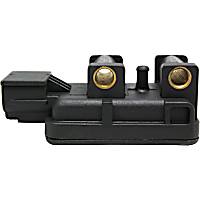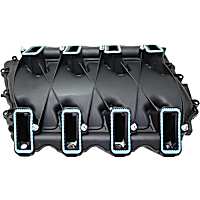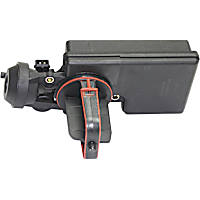OBD-II codes are a series of codes standardized to help mechanics, as well as knowledgeable car owners, troubleshoot problems in a car. These codes contain a combination of letters and numbers that indicates what type of issue they’re for and which system is involved.
An example would be the P2004 code. If you’re getting P2004 on your code reader or scanner, there may be a potential problem with the intake manifold runner control solenoid or its circuit. Read on to learn what does the code P2004 code mean, what are its possible causes, and more.
What Does the P2004 Code Mean?
Diagnostic Trouble Code (DTC) P2004 stands for “Intake Manifold Runner Control Solenoid Bank 1 – Solenoid Stuck Open.”

The intake manifold runner control (IMRC) system is responsible for tuning the airflow inside the intake manifold before that air enters the engine. Not all these systems work the same way. The IMRC systems that store code P2004 have a solenoid that opens and closes the flaps inside the intake manifold. Your car’s primary computer, which is often known as the powertrain control module (PCM), controls the solenoid.
The PCM constantly monitors the IMRC solenoid to make sure it’s functioning correctly. It collects information from various sensors, then uses that data to determine IMRC system operation.
The code P2004 is stored when the PCM believes the IMRC solenoid is stuck in the open position.
For more information that can help you troubleshoot code P2004, read our technical discussion about IMRC configurations.

What are the Possible Causes of the P2004 Code?
There are multiple reasons why the IMRC solenoid can fail. Be mindful that the causes of the problem in your vehicle may differ from other cases you may find online. Here are the common culprits why the code P2004 appeared in your scanner:
- Faulty IMRC solenoid
- Loose or binding intake manifold runners
- Defective intake manifold runner position sensor
- Issues in the IMRC actuator solenoid control circuit
- Bad MAP Sensor
- Corrosion on the IMRC solenoid connector face

What are the Common Symptoms of Code P2004?
Like the causes, you could also experience symptoms that differ from other cases. Here are the most common symptoms you may encounter if the PCM sets the P2004 code:
- Reduced engine performance, especially at low RPM levels
- Increased fuel consumption
- Engine surge
- Clogged vacuum hoses
How to Diagnose the P2004 Code
Properly diagnosing the P2004 code might prove to be challenging. It is a generic trouble code that may be logged in vehicles from various auto manufacturers. Even if different vehicles may experience similar symptoms, diagnosis steps could be different between makes and models.
To get an idea of what diagnosing the P2004 code might involve, you could watch the video below:
How to Fix the P2004 Code
Like diagnosis, fixing the P2004 code could become very tedious. This is especially true if you don’t have the necessary tools and automotive DIY skills to resolve the issue. You could opt to leave the job to your trusted mechanic or you can try to do it yourself.
If you do decide to take on the job yourself, you’ll need the help of a repair manual, like the ones from Chilton, or an ALLDATA single-vehicle subscription.
When researching how to fix code P2004, make sure to focus on solutions that are specific to your vehicle’s year, make, and model. Remember that the steps to fixing the P2004 code may vary from one make and model to another. Also, it would be best to consult your owner’s manual before proceeding with the job.
Finding Replacement Parts to Resolve DTC P2004
Clearing this trouble code typically involves replacing a faulty part. Based on the possible causes mentioned above, you might have to replace anything from a malfunctioning intake manifold runner control solenoid to a bad MAP sensor. Once you’ve pinpointed the culprit, start shopping for the perfect replacement here at CarParts.com.
With our wide selection of high-quality replacement parts that come with accurate and detailed fitment information, you can find exactly what you need in no time. Use our vehicle selector and filters to narrow down our catalog to the components that fit your ride and match your preferences.
Because our warehouses are strategically located all over the US, you can expect your order at your doorstep in as fast as two business days. If you’re shopping on a budget, we have you covered. All our replacement parts come with a low-price guarantee, so you don’t have to break the bank to fix your ride.
Order the replacement part you need today to clear this trouble code in no time.
Products Mentioned in this Guide
Any information provided on this Website is for informational purposes only and is not intended to replace consultation with a professional mechanic. The accuracy and timeliness of the information may change from the time of publication.


 MAP Sensor
MAP Sensor
 Intake Manifold
Intake Manifold
 Intake Manifold Runner Valve
Intake Manifold Runner Valve















